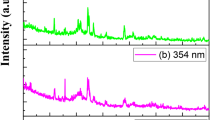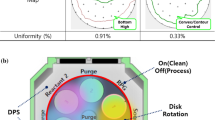Abstract
This paper reports the results of a study on the effect of N-ion implantation on structure and properties of Magnesium Silicide (Mg2Si) thin film that is known to be a potential thermoelectric (TE) material. Mg2Si thin films of thickness 300 nm have been deposited on the silicon (100) substrate at room temperature using the sputtering technique. The thin films have been subjected to 50 keV N-ion implantation under various fluence values ranging from 5 × 1014 to 1 × 1016 ions/cm2. Structural characterization by X-ray Diffraction (XRD) technique has verified that the pristine thin film is constituted by a crystalline single phase Mg2Si material; however, ion irradiation leads to partial amorphization of the Mg2Si thin film. Field–Emission Scanning Electron Microscopy (FE-SEM) with Energy Dispersive Spectroscopy (EDS) is employed to obtain microstructural and compositional information. While particle coarsening due to ion implantation is affirmed by FESEM observation, the EDS study cannot authenticate the exact stoichiometry of the film due to substrate effect. X-ray Photoelectron Spectroscopy (XPS) study was conducted to secure information about the chemical state of the elements at the film surface which confirms the presence of Mg2Si phase in the pristine film; and of both Mg2Si and nitrogen in the implanted thin films. The electrical transport behavior of Mg2Si thin films have been studied by way of I-V and Hall measurements; the conductivity values are found to increase from 6*102 S/m to 1.17*103 S/m as the fluence is raised from 5 × 1014 to 1 × 1016 ions/cm2 at a temperature of 150 °C. The electrical conductivities of all the samples are seen to increase continuously with increasing temperature thereby, showing semiconducting behavior of the thin films.
Graphical abstract

Similar content being viewed by others
Data Availability
No separate data available with the authors.
References
Shi X, Chen L, Uher C, Shi X, Chen L, Uher C (2016) “Recent advances in high-performance bulk thermoelectric materials Recent advances in high-performance bulk thermoelectric materials,” vol. 6608, no. June, pp. 0–37, https://doi.org/10.1080/09506608.2016.1183075
Mamindla R, Niranjan MK (2020) Surface electronic structure, relaxations and thermodynamic energies of (100), (110) and (111) surfaces of Mg2Si: A first-principles theoretical study. Surf Sci 691(July 2019):121506. https://doi.org/10.1016/j.susc.2019.121506
Langouche G, Mahan JE, Becker JP (1996) “Semiconducting Mg 2 Si thin films prepared by molecular-beam epitaxy,” vol. 54, no. 23, pp. 965–971
Vantomme A et al (2014) “Thin film growth of semiconducting Mg 2 Si by codeposition Thin film growth of semiconducting Mg 2 Si by codeposition,” vol. 1086, no. 1997, pp. 10–13, https://doi.org/10.1063/1.118492
Vantomme A, Langouche G, Mahan JE, J. P. Becker (2000) “Growth mechanism and optical properties of semiconducting Mg 2 Si thin films,” vol. 50, pp. 237–242
Howlader S, Vasudevan R, Jarwal B, Gupta S, Chen K (2020) Microstructure and mechanical stability of Bi doped Mg 2 Si 0. 4 Sn 0. 6 thermoelectric material. J Alloys Compd 818:152888. https://doi.org/10.1016/j.jallcom.2019.152888
Narducci D, Selezneva E, Cerofolini G, Frabboni S, Ottaviani G (2012) Impact of energy filtering and carrier localization on the thermoelectric properties of granular semiconductors. J Solid State Chem 193:19–25. https://doi.org/10.1016/j.jssc.2012.03.032
Goldsmid HJ (2016) Optimisation and selection of semiconductor thermoelements, vol. 121. https://doi.org/10.1007/978-3-662-49256-7_4
Kurokawa M, Shimizu T, Uehara M, Katagiri A, Akiyama K, Matsushima M (2018) “Control of p - and n -type Conduction in Thermoelectric Non-doped Mg 2 Si Thin Films Prepared by Sputtering Method,” vol. 2, https://doi.org/10.1557/adv.2018
Vaulx D et al (2016) “Effect of texture on the structural and transport properties of Sb-doped Mg 2 Si thin fi lms,” vol. 688, pp. 195–201, https://doi.org/10.1016/j.jallcom.2016.07.111
Xiao Q, Xie Q, Shen X, Zhang J, Yu Z, Zhao K (2011) Applied Surface Science Effects of magnesium film thickness and annealing temperature on formation of Mg 2 Si films on silicon ( 1 1 1 ) substrate deposited by magnetron sputtering. Appl Surf Sci 257(17):7800–7804. https://doi.org/10.1016/j.apsusc.2011.04.032
Ogawa S et al (2014) “Electrical Properties of ( 110 ) -Oriented Nondoped Mg 2 Si Films with p -Type Conduction Prepared by RF Magnetron Sputtering Method,” no. 110, pp. 2–6, https://doi.org/10.1007/s11664-014-3040-6
Tani J, Kido H (2015) “Electrical properties of Mg 2 Si thin fi lms on fl exible polyimide substrates fabricated by radio-frequency magnetron sputtering,” vol. 8320, pp. 298–301
Zhang B et al (2017) “Electrical transport characterization of Al and Sn doped Mg 2 Si thin fi lms,” vol. 720, pp. 156–160
Kogut I, Record MC (2013) Growth of magnesium silicide thin films on Si(100), Si(111) and SOI substrates during rapid thermal processing. Intermetallics 32:184–193. https://doi.org/10.1016/j.intermet.2012.08.029
“Magnesium silicide thin film formation by reactive diffusion _ Elsevier Enhanced Reader.pdf”
Manuscript A (2020) “Ac ce d M pt,”
Gouralnik AS, Shevlyagin AV, Chernev IM, Yu A, Gerasimenko AV, Gutakovskii AK (2021) Synthesis of crystalline Mg 2 Si films by ultrafast deposition of Mg on Si ( 111 ) and Si ( 001 ) at high temperatures. Mg / Si intermixing and reaction mechanisms. Mater Chem Phys 258(October 2020):123903. https://doi.org/10.1016/j.matchemphys.2020.123903
Singh S, Sharma V, Asokan K, Sachdev K (2018) NTO/ag/NTO multilayer transparent conducting electrodes for photovoltaic applications tuned by low energy ion implantation. Sol Energy 173(February):651–664. https://doi.org/10.1016/j.solener.2018.08.001
Masarrat A et al (2019) Effect of Fe ion implantation on the thermoelectric properties and electronic structures of CoSb3 thin films. RSC Adv 9(62):36113–36122. https://doi.org/10.1039/c9ra06873b
Keshri S, Kumar A, Kabiraj D (2012) Tailoring of optical and gas sensitivity behaviors of WO3 films by low energy Ar+ ion implantation. Thin Solid Films 526:50–58. https://doi.org/10.1016/j.tsf.2012.10.101
Series S (1980) Mater Sci, vol. 208, no. 4439. https://doi.org/10.1126/science.208.4439.30
Shyam R et al (2021) Study of light-emitting defects induced by 100 MeV Ag ion irradiation in potassium sodium niobate thin films. J Lumin 233(December 2020):117909. https://doi.org/10.1016/j.jlumin.2021.117909
R. Shyam, D. Negi, A. Das, P. Dobbidi, and S. R. Nelamarri, “Investigation of structural and morphological properties of high energy ion irradiated KNN films,” Mater Res Express, vol. 8, no. 6, pp. 0–12, 2021, https://doi.org/10.1088/2053-1591/ac02ff
Bala M et al (2016) Nuclear Instruments and methods in physics research B formation of nanodots and enhancement of thermoelectric power induced by ion irradiation in PbTe : ag composite thin films. Nucl Inst Methods Phys Res B 379:36–41. https://doi.org/10.1016/j.nimb.2016.03.006
Bhogra A et al (2019) Tuning the electrical and thermoelectric properties of N ion implanted SrTiO3 thin films and their conduction mechanisms. Sci Rep 9(1):1–11. https://doi.org/10.1038/s41598-019-51079-y
Singh S, Sharma V, Saini D, Shekhawat S, Asokan K, Sachdev K (2018) “Materials Science in Semiconductor Processing In fl uence of 100 keV Ar + implantation on electrical and optical properties of TiO 2 / Ag / TiO 2 multilayer fi lms,” vol. 75, no. September 2017, pp. 18–25, https://doi.org/10.1016/j.mssp.2017.11.016
Singh S, Sharma V, Saini D, Asokan K, Sachdev K (2017) “Fabrication of highly e ffi cient TiO 2 / Ag / TiO 2 multilayer transparent conducting electrode with N ion implantation for optoelectronic applications,” vol. 43, no. January, pp. 9759–9768, https://doi.org/10.1016/j.ceramint.2017.04.152
Tureson N et al (2018) Effect of ion-implantation-induced defects and mg dopants on the thermoelectric properties of ScN. Phys Rev B 98(20):1–9. https://doi.org/10.1103/PhysRevB.98.205307
Sari AH, Salem MK, Shoorche A (2011) Effect of nitrogen ion implantation in copper. J Fusion Energ 30(4):323–327. https://doi.org/10.1007/s10894-011-9381-8
Kaminski M, Budzynski P, Wiertel M, Drozdziel A (2018) Use of nitrogen ion implantation for modification of the tribological properties of titanium alloy Ti6Al4V. IOP Conf Ser Mater Sci Eng 421(3). https://doi.org/10.1088/1757-899X/421/3/032013
Instruments N, Company NP (1983) “I z5,” vol. 210, pp. 581–587
Sn MS (2020) “Materials today : proceedings thermoelectric transport and microstructural study of cu doped,” Mater Today Proc, no. xxxx, pp. 4–7, https://doi.org/10.1016/j.matpr.2020.04.668
Gupta S, Howlader S, Sharma A, Banerjee MK, Asokan K, Sachdev K (2020) “Materials today : proceedings structural and electrical properties of mg silicide thin films deposited by RF sputtering,” Mater Today Proc, no. xxxx, https://doi.org/10.1016/j.matpr.2020.03.721
Gupta S, Howlader S, Sharma A, Banerjee KAMK (2022) “ORIGINAL RESEARCH ARTICLE a study on the characteristics of mg 2 Si films prepared by Electron beam evaporation technique,” J Electron Mater, no. 0123456789, https://doi.org/10.1007/s11664-022-09568-w
Oxide A, Measurement T (2009) “X-Ray Photoelectron Spectroscopy Reference Pages,” no. 1, pp. 19–21, [Online]. Available: http://www.xpsfitting.com/2009/10/molybdenum.html
Huang HH, Shih WC, Lai CH (2010) Nonpolar resistive switching in the Pt/MgO/Pt nonvolatile memory device. Appl Phys Lett 96(19):2012–2015. https://doi.org/10.1063/1.3429024
Energy B, “X-ray Photoelectron Spectroscopy ( XPS ) Analysis of Materials,” pp. 1–22
Excitation IX, Shevchik NJ, Lanqer DW, Schonherr E (1973) “Photoelectric Properties of Mg,Si, Mg,Ge, and Mg,Sn,” vol. 189, no. I
Kaur A, Chahal P, Hogan T (2016) “Selective Fabrication of SiC / Si Diodes by Excimer Laser Under Ambient Conditions,” vol. 37, no. 2, pp. 142–145
Yang CH, Lee SC, Chen SC, Lin TC (2006) The effect of annealing treatment on microstructure and properties of indium tin oxides films. Mater Sci Eng B Solid-State Mater Adv Technol 129(1–3):154–160. https://doi.org/10.1016/j.mseb.2006.01.012
Sinduja M, Amirthapandian S, Masarrat A, Krishnan R, Srivastava SK, Kandasami A (2020) Investigations on morphology and thermoelectric transport properties of cu+ ion implanted bismuth telluride thin film. Thin Solid Films 697(January):137834. https://doi.org/10.1016/j.tsf.2020.137834
Rao MV (1993) Ion implantation in III-V compound semiconductors. Nucl Inst Methods Phys Res B 79(1–4):645–647. https://doi.org/10.1016/0168-583X(93)95433-6
Hartman P, Chan HK (1993) Application of the periodic bond chain (PBC) theory and attachment Energy consideration to derive the crystal morphology of Hexamethylmelamine. Pharm Res An Off J Am Assoc Pharm Sci 10(7):1052–1058. https://doi.org/10.1023/A:1018927109487
Bala M et al (2017) “Enhancement of thermoelectric power of PbTe thin films by ag ion implantation,” J Appl Phys, vol. 121, no. 21, https://doi.org/10.1063/1.4984050
Wei Z, Li Z, Luo P, Zhang J, Luo J (2020) Simultaneously increased carrier concentration and mobility in p-type Bi0.5Sb1.5Te3 throng cd doping. J Alloys Compd 830:154625. https://doi.org/10.1016/j.jallcom.2020.154625
Acknowledgements
The authors are grateful to the Inter-University Accelerator Center for providing the ion implantation facilities at their institute. The authors would like to acknowledge Materials Research Center facility at MNIT Jaipur for characterization facilities.
Funding
This work was supported by UGC-IUAC (Inter University Accelerator Center, Grant No: 62334) for implantation on Mg Silicide thin films.
Author information
Authors and Affiliations
Contributions
Suniksha Gupta performed the experiment which included the synthesis of the films, implantation (at IUAC, New Delhi) and their characterization. Further the original draft was also prepared by her which includes the plotting and analysis of experimental data. Data conceptualization for XRD, XPS, I-V, SEM, was concluded by her. The data curation for the manuscript was carried forward by her. Smita Howlader assisted in draft preparation and the XRD analysis. Further formal analysis of the data and conceptualization was looked by her. Satyavir Singh assisted in the whole implantation process which includes SRIM/TRIM software, selecting energy of particular ions and their analysis part. Atul Sharma helped in the deposition of films and optimization of process parameters hence the methodology to get good quality films. M.K. Banerjee mentored the synthesis part, providing guidance through the problems encountered and corrected the manuscript. K. Asokan was involved in discussions regarding the complete work and also looked after the XRD, I-V and Hall data analysis part. The project was conceptualized by Kanupriya Sachdev. The final approval of the manuscript after thorough checking of all the important aspects i.e., reporting of synthesis process, data analysis and further reviewed by her. The research work was done under the supervision of Kanupriya Sachdev, M.K. Banerjee and K. Asokan with their constant support we were able to achieve the required results. The research was funded by a project granted from IUAC (Project. No. 62334). MRC, MNIT allowed to use the resources for the research work. Software’s used to plot the data was Origin, Casa, and MS Office.
Corresponding author
Ethics declarations
Ethical Approval
Study requires no ethical approvals. Manuscript is in compliance with ethical standards.
Consent to Participate
Not Applicable.
Consent for Publication
Consent to publish has been received from all authors.
Competing Interests
The authors declare no competing interests.
Dual Publication Statement
The authors declare that the manuscript is not submitted elsewhere.
Additional information
Publisher’s Note
Springer Nature remains neutral with regard to jurisdictional claims in published maps and institutional affiliations.
Rights and permissions
Springer Nature or its licensor (e.g. a society or other partner) holds exclusive rights to this article under a publishing agreement with the author(s) or other rightsholder(s); author self-archiving of the accepted manuscript version of this article is solely governed by the terms of such publishing agreement and applicable law.
About this article
Cite this article
Gupta, S., Howlader, S., Singh, S. et al. A Study on the Effect of 50 keV Nitrogen Ion Implantation in Mg2Si Thin Films. Silicon 15, 6521–6532 (2023). https://doi.org/10.1007/s12633-023-02521-4
Received:
Accepted:
Published:
Issue Date:
DOI: https://doi.org/10.1007/s12633-023-02521-4




